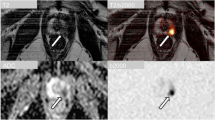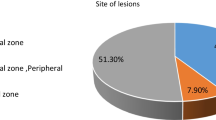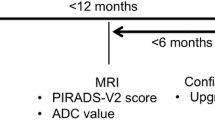Abstract
Purpose
To study the detection of clinically significant prostate cancer (PCa) by readers with different experience, comparing performance with biparametric magnetic resonance imaging (bmMRI) and with the reference multiparametric (mpMRI).
Methods
Retrospective analysis of 68 patients with mpMRI of the prostate at 1.5 Tesla using a 32 phased-array coil. Forty-five patients (cases) underwent radical prostatectomy, whereas 23 (controls) had a negative prostate biopsy and ≥ 2.5 years of negative follow-up. Six observers (two with 1000 cases interpreted, two with 300, two with 100) performed the analysis first with bpMRI including diffusion-weighted imaging (DWI), apparent diffusion coefficient (ADC) maps and T2-weighted (T2W) imaging in three planes and, after 1 month, with mpMRI, adding dynamic contrast enhancement (DCE). The performance was quantified by sensitivity (SNS), specificity (SPC) and area under the curve (AUC) of the ROC (Receiver Operating Characteristics) procedure.
Results
Concordance within observers of equivalent experience was good (weighted Cohen’s k ≈ 0.7). The two expert readers performed as well in bpMRI as in mpMRI (SNS = 0.91–0.96, AUC = 0.86–0.93; p ≥ 0.10); readers with 300 cases performed well in mpMRI, but significantly worse in bpMR: SNS = 0.58 versus 0.91 (p < 0.0001) and AUC = 0.73 versus 0.86 (p = 0.01); the limited experience of readers with 100 cases showed in mpMRI (SNS = 0.71; AUC = 0.77) and even more in bpMRI (SNS = 0.50; AUC = 0.68).
Conclusion
The study revealed the impact of the readers’ experience when using bpMRI. The bpMRI without contrast media was a valid alternative for expert readers, whereas less experienced ones needed DCE to significantly boost SNS and AUC. Results indicate 700–800 cases as threshold for reliable interpretation with bpMRI.




Similar content being viewed by others
References
Ahmed HU, El-Shater Bosaily A, Brown LC, et al (2017) Diagnostic accuracy of multi-parametric MRI and TRUS biopsy in prostate cancer (PROMIS): a paired validating confirmatory study. Lancet Lond Engl 389:815–822. https://doi.org/10.1016/S0140-6736(16)32401-1
Mottet N, Bellmunt J, Bolla M, et al (2017) EAU-ESTRO-SIOG Guidelines on Prostate Cancer. Part 1: Screening, Diagnosis, and Local Treatment with Curative Intent. Eur Urol 71:618–629. https://doi.org/10.1016/j.eururo.2016.08.003
Marra G, Gontero P, Valerio M (2016) Changing the prostate cancer management pathway: why Focal Therapy is a step forward. Arch Esp Urol 69:271–280
Weinreb JC, Barentsz JO, Choyke PL, et al (2016) PI-RADS Prostate Imaging – Reporting and Data System: 2015, Version 2. Eur Urol 69:16–40. https://doi.org/10.1016/j.eururo.2015.08.052
Delongchamps NB, Beuvon F, Eiss D, et al (2011) Multiparametric MRI is helpful to predict tumor focality, stage, and size in patients diagnosed with unilateral low-risk prostate cancer. Prostate Cancer Prostatic Dis 14:232–237. https://doi.org/10.1038/pcan.2011.9
Tamada T, Sone T, Higashi H, et al (2011) Prostate cancer detection in patients with total serum prostate-specific antigen levels of 4-10 ng/mL: diagnostic efficacy of diffusion-weighted imaging, dynamic contrast-enhanced MRI, and T2-weighted imaging. AJR Am J Roentgenol 197:664–670. https://doi.org/10.2214/AJR.10.5923
Schimmöller L, Quentin M, Arsov C, et al (2014) MR-sequences for prostate cancer diagnostics: validation based on the PI-RADS scoring system and targeted MR-guided in-bore biopsy. Eur Radiol 24:2582–2589. https://doi.org/10.1007/s00330-014-3276-9
Rais-Bahrami S, Siddiqui MM, Vourganti S, et al (2015) Diagnostic value of biparametric magnetic resonance imaging (MRI) as an adjunct to prostate-specific antigen (PSA)-based detection of prostate cancer in men without prior biopsies. BJU Int 115:381–388. https://doi.org/10.1111/bju.12639
Fascelli M, Rais-Bahrami S, Sankineni S, et al (2016) Combined Biparametric Prostate Magnetic Resonance Imaging and Prostate-specific Antigen in the Detection of Prostate Cancer: A Validation Study in a Biopsy-naive Patient Population. Urology 88:125–134. https://doi.org/10.1016/j.urology.2015.09.035
Radtke JP, Boxler S, Kuru TH, et al (2015) Improved detection of anterior fibromuscular stroma and transition zone prostate cancer using biparametric and multiparametric MRI with MRI-targeted biopsy and MRI-US fusion guidance. Prostate Cancer Prostatic Dis 18:288–296. https://doi.org/10.1038/pcan.2015.29
Stanzione A, Imbriaco M, Cocozza S, et al (2016) Biparametric 3T Magentic Resonance Imaging for prostatic cancer detection in a biopsy-naïve patient population: a further improvement of PI-RADS v2? Eur J Radiol 85:2269–2274. https://doi.org/10.1016/j.ejrad.2016.10.009
Thestrup KCD, Logager V, Baslev I, et al (2016) Biparametric versus multiparametric MRI in the diagnosis of prostate cancer. Acta Radiol Open 5:2058460116663046. https://doi.org/10.1177/2058460116663046
Barth BK, De Visschere PJL, Cornelius A, et al (2017) Detection of Clinically Significant Prostate Cancer: Short Dual-Pulse Sequence versus Standard Multiparametric MR Imaging-A Multireader Study. Radiology 162020. https://doi.org/10.1148/radiol.2017162020
De Visschere P, Lumen N, Ost P, et al (2017) Dynamic contrast-enhanced imaging has limited added value over T2-weighted imaging and diffusion-weighted imaging when using PI-RADSv2 for diagnosis of clinically significant prostate cancer in patients with elevated PSA. Clin Radiol 72:23–32. https://doi.org/10.1016/j.crad.2016.09.011
Scialpi M, Prosperi E, D’Andrea A, et al (2017) Biparametric versus Multiparametric MRI with Non-endorectal Coil at 3T in the Detection and Localization of Prostate Cancer. Anticancer Res 37:1263–1271. https://doi.org/10.21873/anticanres.11443
Kuhl CK, Bruhn R, Krämer N, et al (2017) Abbreviated Biparametric Prostate MR Imaging in Men with Elevated Prostate-specific Antigen. Radiology 285:493–505. https://doi.org/10.1148/radiol.2017170129
Gaziev G, Wadhwa K, Barrett T, et al (2016) Defining the learning curve for multiparametric magnetic resonance imaging (MRI) of the prostate using MRI-transrectal ultrasonography (TRUS) fusion-guided transperineal prostate biopsies as a validation tool. BJU Int 117:80–86. https://doi.org/10.1111/bju.12892
Rosenkrantz AB, Ayoola A, Hoffman D, et al (2017) The Learning Curve in Prostate MRI Interpretation: Self-Directed Learning Versus Continual Reader Feedback. AJR Am J Roentgenol 208:W92–W100. https://doi.org/10.2214/AJR.16.16876
Vargas HA, Hötker AM, Goldman DA, et al (2016) Updated prostate imaging reporting and data system (PIRADS v2) recommendations for the detection of clinically significant prostate cancer using multiparametric MRI: critical evaluation using whole-mount pathology as standard of reference. Eur Radiol 26:1606–1612. https://doi.org/10.1007/s00330-015-4015-6
Ahmed HU (2009) The index lesion and the origin of prostate cancer. N Engl J Med 361:1704–1706. https://doi.org/10.1056/NEJMcibr0905562
Russo F, Regge D, Armando E, et al (2016) Detection of prostate cancer index lesions with multiparametric magnetic resonance imaging (mp-MRI) using whole-mount histological sections as the reference standard. BJU Int 118:84–94. https://doi.org/10.1111/bju.13234
Epstein JI, Amin MB, Reuter VE, Humphrey PA (2017) Contemporary Gleason Grading of Prostatic Carcinoma: An Update With Discussion on Practical Issues to Implement the 2014 International Society of Urological Pathology (ISUP) Consensus Conference on Gleason Grading of Prostatic Carcinoma. Am J Surg Pathol 41:e1–e7. https://doi.org/10.1097/PAS.0000000000000820
Hanley JA, McNeil BJ (1983) A method of comparing the areas under receiver operating characteristic curves derived from the same cases. Radiology 148:839–843. https://doi.org/10.1148/radiology.148.3.6878708
Greer MD, Brown AM, Shih JH, et al (2017) Accuracy and agreement of PIRADSv2 for prostate cancer mpMRI: A multireader study. J Magn Reson Imaging JMRI 45:579–585. https://doi.org/10.1002/jmri.25372
Rosenkrantz AB, Oto A, Turkbey B, Westphalen AC (2016) Prostate Imaging Reporting and Data System (PI-RADS), Version 2: A Critical Look. AJR Am J Roentgenol 206:1179–1183. https://doi.org/10.2214/AJR.15.15765
Ullrich T, Quentin M, Oelers C, et al (2017) Magnetic resonance imaging of the prostate at 1.5 versus 3.0T: A prospective comparison study of image quality. Eur J Radiol 90:192–197. https://doi.org/10.1016/j.ejrad.2017.02.044
Author information
Authors and Affiliations
Corresponding author
Ethics declarations
Conflict of interest
The authors declare that they have no conflict of interest.
Ethical approval
All procedures performed in studies involving human participants were in accordance with the ethical standards of the institutional and/or national research committee and with the 1964 Helsinki Declaration and its later amendments or comparable ethical standards.
Informed consent
Informed consent was obtained from all individual participants included in the study.
Additional information
Publisher's Note
Springer Nature remains neutral with regard to jurisdictional claims in published maps and institutional affiliations.
Rights and permissions
About this article
Cite this article
Gatti, M., Faletti, R., Calleris, G. et al. Prostate cancer detection with biparametric magnetic resonance imaging (bpMRI) by readers with different experience: performance and comparison with multiparametric (mpMRI). Abdom Radiol 44, 1883–1893 (2019). https://doi.org/10.1007/s00261-019-01934-3
Published:
Issue Date:
DOI: https://doi.org/10.1007/s00261-019-01934-3




